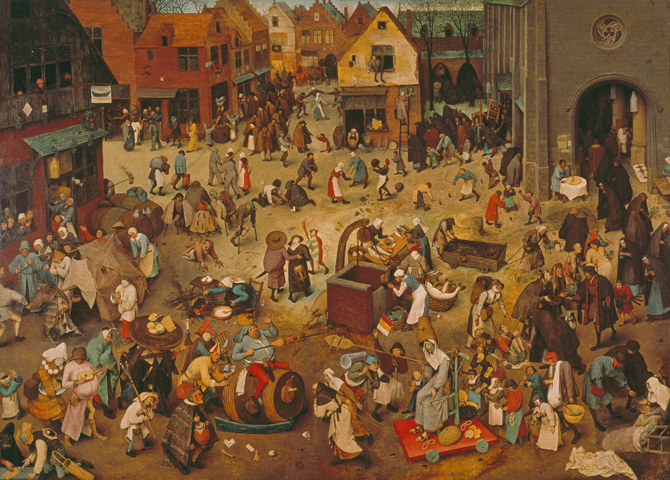Fr : version française / En: english version
mheu, Historical Museum of the Urban Environment
The Fight Between Carnival and Lent
Pieter Bruegel The Elder

1559
118cm x 164.5cm
oil on wood (oak)
Vienna, Kunsthistorisches Museum
© Joseph S. Martin - ARTOTHEK
View this work in the exhibition The Street
The work
Before painting this picture, Bruegel traveled in Italy, visiting Naples in 1552 and Rome in 1552-53, at the time still home to Michelangelo. Yet it would appear that Italian painting—traces of which can been seen by the careful observer in The Port of Naples and The Fall of Icarus—failed to influence him.
The Fight Between Carnival and Lent, now hanging in Vienna, Austria, is a true Flemish work: a common celebration—a genre painting still highly popular—in which the only real visible influence on the portrayal of the people and their disguises is that of Hieronymus Bosch, who died in 1516, shortly after Bruegel was born. In this work, Bruegel adopts a high-angle viewpoint, shunning the central perspective so dear to the Italians. The picture comprises an ellipse that closes around the roofs of the houses, with the figures evenly spread out in a symmetrical fashion beginning in the foreground and set around an invisible central line. The festive atmosphere, with its contrast between Lent (lean) and Carnival (fat), may also hint at the violence caused by another conflict (Catholics against Lutherans), which brought about the bloody suppression led by the Duka of Alba, starting in 1567.
The artist
Not much is known about Pieter Bruegel "The Elder", not even his exact date of birth, which has been estimated circa 1525-1530. However, we do know that he died in 1569. The death certificate states that he died medio aetatis flore (in the prime of his life); it is therefore estimated that he lived until around 40 years of age.
Nor do we know where he was born: Breda in the Netherlands or Bree in Belgian (also called Breda in Latin). His name first appears in 1551 in Antwerp, where he ranked among the masters of the guild of Saint Luke. The following year, he traveled to Italy. It is thought that he rubbed shoulders with both rich patrons and rural folk, whose weddings he attended.
In 1562, he left Antwerp and set up home in Brussels, where he married the daughter of the painter Pieter Coecke van Aelst in 1563. Some stories suggest the latter was also his mentor. His first son, Pieter Bruegel "The Younger", was born in 1564, and the second, Jan de Velours, in 1568, both of whom took up as painters and continued to promote the Bruegel style after their father's death in 1569—a style that remained highly popular throughout the 16th century.